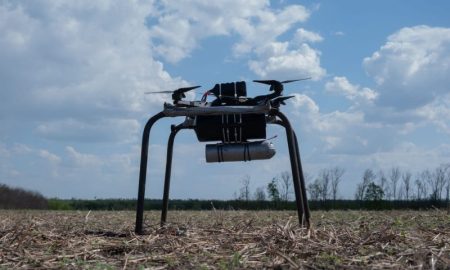
China Builds 50m-Tall Inflatable Dome to Reduce Construction Pollution

Cities deal with construction dust and noise daily. But a new dome in Jinan, in eastern China’s Shandong province, is changing that. This inflatable shell rises 50 meters over a massive site, shielding nearby streets from harmful particles and loud machinery. It is a bold test of greener, smarter building methods.
Essentially, a dome acts as a barrier that keeps fine construction dust from drifting into crowded neighborhoods. It traps debris inside its inflated walls, protecting the air outside. Workers continue their tasks while nearby residents breathe cleaner air, even when heavy machinery runs nonstop.
Constant air flow maintains the dome’s structure without rigid frames. Fans regulate the pressure so the cover stays firm over the site. This design reduces weight and allows quick setup, making it easier to handle large areas without heavy steel or concrete shells.

Mechanics Mix / Facebook / The dome dampens construction noise and prevents dust and debris from spreading into the air.
The thick fabric softens the roar of drills and trucks. Residents hear far less disruption while crews work long hours. For cities where building projects sit close to schools and homes, this quiet buffer gives communities relief from long construction schedules.
This dome spans 20,000 square meters, easily wrapping around cranes and scaffolds. It fits a full-scale construction site with room to move equipment. Large enclosures like this let developers run ambitious builds without spreading dust clouds beyond the fence line.
The Dome Has Year-round Use Without Weather Stops!
Rain or harsh winds often stall construction. Inside a dome, crews keep working during sandstorms or freezing temperatures. Temperature and humidity controls maintain steady conditions, letting projects finish faster despite unpredictable seasonal changes in the climate.

The Strait Times / Unlike fixed steel sheds, an inflatable dome packs up fast. Teams can deflate it, move it to another site, and inflate it again within days.
This reusability reduces costs and waste, and makes the system practical for cities with continuous building schedules.
Dust from construction carries fine particles like PM2.5 that harm lungs. A dome stops most of that material before it leaves the site. Fewer particles reach nearby schools, shops, and apartments, lowering risks for people with asthma or other respiratory issues.
China just said build it quiet & dropped a 50m-tall inflatable dome over a construction site in Jinan
‘It’s the world’s biggest’ — 20,000㎡ of puffed-up silence
No dust
No noise pic.twitter.com/cbix9U8Gdm
— RT (@RT_com) July 2, 2025
Urban centers in China struggle with pollution from multiple sources. By trapping debris, each dome contributes to local air quality. Cleaner air supports healthier communities, making cities more livable even as they expand with rapid construction.
Projects often spark frustration in neighborhoods because of noise and mess. A dome reduces both, cutting down on formal complaints to local authorities. Construction teams face less conflict with nearby businesses and can maintain better relations with the public.
Some projects sit in crowded zones where building a rigid cover would take months. A dome goes up quickly with minimal disruption around it. Crews can start interior work sooner, avoiding long lead times that slow city development.
Officials from other countries are watching how China uses these domes. Urban planners in areas with dense populations see promise in adapting this method. If adopted widely, it could become a common feature on sites with strict environmental rules.
More in Latest News
-
`
Key Highlights From UFC 317 (June 26 – 29, 2025)
UFC 317 took over Las Vegas from June 26 to 29, 2025, and it didn’t waste a second. Fights were fast,...
July 9, 2025 -
`
Who Invented Basketball? Here’s All You Need to Know
Basketball didn’t just show up one day. It had to be invented. The story most people know starts in 1891 with...
July 3, 2025 -
`
What to Do (And What to Avoid) Before a Cruise
A cruise vacation is an incredible escape from the daily grind, offering relaxation, adventure, and the chance to explore new places....
June 25, 2025 -
`
Big Ten Basketball Power Rankings 2025. Can You Guess Who’s #1?
Big Ten basketball is once again the loudest, toughest, and deepest show in college hoops. The 2024-25 season was stacked with...
June 18, 2025 -
`
How Russia Is Using ‘Terrifying’ Fiber Optic Drones in Ukraine
In Ukraine, the battlefield is changing fast. Russian drones are not just flying cameras anymore, they are controlled by fiber optic...
June 11, 2025 -
`
Top 5 College Football Teams for the 2025 Season Ranked
College football is about to get wild in 2025. After two years of Big Ten dominance, the SEC is ready to...
June 3, 2025 -
`
Famed British Dancer Jordan Banjo Set to Make Huge Misfit Boxing Debut
Jordan Banjo is trading in his dance shoes for boxing gloves, and fans can’t stop talking about it. The 32-year-old British...
May 29, 2025 -
`
5x Olympic Gold Medalist Sue Bird Becomes Managing Director of USA Women’s National Team
Sue Bird is not done making moves yet. After stacking five Olympic gold medals and running the show as point guard...
May 21, 2025 -
`
Russia Pushes Into Sumy, New ‘Security Strip’ Sparks Fresh Fears for Ukraine
Russia has kicked off a fresh push in Ukraine’s northeast, claiming to have forced Ukrainian troops out of the Kursk region...
May 14, 2025















You must be logged in to post a comment Login